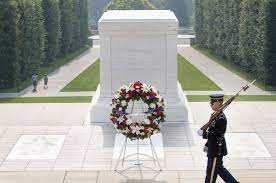The Tomb of the Unknown Soldier — The history behind this “Soul of America” Memorial
 The numbers 11-11-11 have always been significant when I think of November 11. Yesterday was that day that we now refer to as Veteran’s Day in America or is referred to as Remembrance Day in Canada. Those numbers, 11-11-11, refer to the day and time that the cease fire that ended World War I in 1918 became effective. It was at 11 am on the eleventh day of the eleventh month (November) that the armistice (Latin for “stilling of arms”) came to be.
The numbers 11-11-11 have always been significant when I think of November 11. Yesterday was that day that we now refer to as Veteran’s Day in America or is referred to as Remembrance Day in Canada. Those numbers, 11-11-11, refer to the day and time that the cease fire that ended World War I in 1918 became effective. It was at 11 am on the eleventh day of the eleventh month (November) that the armistice (Latin for “stilling of arms”) came to be.
So that day has been 103 years since yesterday. However, yesterday in the United States, we celebrated the 100th anniversary of the Tomb of the Unknown Soldier at Arlington National Cemetery that was dedicated on November 11, 1921. Have you ever wondered how that tomb came to be?
Here’s the story as taken from the official United States Military Arlington National Cemetery website. They tell it better than I can so it follows verbatim:
“During World War I, U.S. service members received aluminum identification discs, the precursors to “dog tags,” to aid the process of identifying remains. The War Department created a new unit in the Quartermaster Corps, the Graves Registration Service, to oversee burials. During and after World War I, however, Americans debated whether bodies should be repatriated. With more than 100,000 U.S. casualties (compared to fewer than 3,000 in the Spanish-American War), repatriation was more challenging.
France and Great Britain, which suffered significantly higher casualties and more unknown dead than did the United States, barred repatriation of their citizens’ remains. To ease the grief of their citizens, France and Great Britain each repatriated and buried one unknown soldier on Armistice Day, November 11, 1920. Great Britain buried its Unknown Warrior inside Westminster Abbey in London, and France buried its Unknown Soldier at the base of the Arc de Triomphe in Paris. These unknowns would stand in for other British and French service members whose remains could not be identified.
The American policy, by contrast, gave options to families of the war dead. If requested by the next of kin, the remains of service members who died in Europe would be transported to anywhere in the United States at no cost to the family. Or, families could choose to bury their dead at permanent U.S. military cemeteries to be established in Europe.
In December 1920, New York Congressman and World War I veteran Hamilton Fish Jr. proposed legislation that provided for the interment of one unknown American soldier at a special tomb to be built in Arlington National Cemetery. The purpose of the legislation was “to bring home the body of an unknown American warrior who in himself represents no section, creed, or race in the late war and who typifies, moreover, the soul of America and the supreme sacrifice of her heroic dead.”
In October 1921, four bodies of unidentified U.S. military personnel were exhumed from different American military cemeteries in France. On October 23, 1921, the four caskets arrived at the city hall of Châlons-sur-Marne (now called Châlons-en-Champagne), France.
Town officials and members of the U.S. Army’s Quartermaster Corps had prepared the city hall for the selection ceremony. Early on the morning of October 24, 1921, Maj. Robert P. Harbold of the Quartermaster Corps, aided by French and American soldiers, rearranged the caskets so that each rested on a shipping case other than the one in which it had arrived. Major Harbold then chose Sgt. Edward F. Younger of Headquarters Company, 2nd Battalion, 50th Infantry, American Forces in Germany, to select the Unknown Soldier. Sgt. Younger selected the Unknown by placing a spray of white roses on one of the caskets.
From Châlons-sur-Marne, the Unknown journeyed by caisson and rail to the port town of Le Havre, France. From Le Havre, the USS Olympia transported the Unknown Soldier’s casket to Washington, D.C. The Unknown arrived at the Washington Navy Yard on November 9, 1921. After arriving in Washington, D.C. on November 9, 1921, the Unknown lay in state in the U.S. Capitol Rotunda. About 90,000 visitors paid their respects during the public visiting period on November 10, 1921.
On November 11, 1921, the Unknown was placed on a horse-drawn caisson and carried in a procession through Washington, D.C. and across the Potomac River. A state funeral ceremony was held at Arlington National Cemetery’s new Memorial Amphitheater, and the Unknown was interred in the Tomb of the Unknown Soldier. Nationwide, Americans observed two minutes of silence at the beginning of the ceremony. President Warren G. Harding officiated at the ceremony and placed the Medal of Honor, the nation’s highest military decoration, on the casket. Numerous foreign dignitaries presented their nations’ highest awards, as well.
Originally, the Tomb of the Unknown Soldier consisted of a simple marble slab. During its early years, thousands of visitors came to Arlington National Cemetery to mourn at the Tomb and to pay their respects to the Unknown Soldier and the military personnel he represented.
The Tomb sarcophagus is decorated with three wreaths on each side panel (north and south). On the front (east), three figures represent Peace, Victory and Valor. The back (west) features the inscription: “Here rests in honored glory an American soldier known but to God.”
Here is the official U.S. Military website for Arlington National Cemetery and the page of the Tomb of the Unknown Soldier.
May God Bless the United States of America. Have a great weekend!!
Enter your e-mail below to join the 2,442 others who receive Funeral Director Daily articles daily:





















